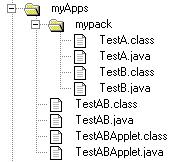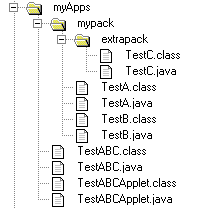
| Home : Course Map : Chapter 5 : Java : |
|
Java Files & Packages
Namespace and import |
| JavaTech |
| Course Map |
| Chapter 5 |
|
File/Package/Import Demo 1 Demo 2 Access/Visibility final & Constants Static Import Jar Files Demo 3 Applet Directories 3rd Party Packages CLASSPATH javadoc CodingConventions Exercises |
|
Supplements
|
| About
JavaTech Codes List Exercises Feedback References Resources Tips Topic Index Course Guide What's New |
|
Class Definition Files Files containing Java class definitions follow these guidelines;
A package is the Java version of a library. A package refers simply to a group of related class files in the same directory and having in each class file a package directive (Java statements only occur within a class definition) with that directory name at the top of the file. For example, say that we put the files TestA.java and TestB.java into the directory mypack, which is a subdirectory of myApps. So on a MS Windows platform the file path looks like c:\myApps\mypack\TestA.java and c:\myApps\mypack\TestB.java. At the top of each file we put the statement package mypack; as shown in the following code:
We can illustrate how to use a package with TestAB.java which we put in the next directory above that of the package mypack.
From the command line in the directory myApps, the compilation of TestAB.java: myApps> javac TestAB.java will also lead to the compilation of the files in mypack. The compiler looks for the TestA and TestB class definitions using the combination of the package and class names mypack.TestA testa and mypack.TestB. The "." acts in this case like the slash line directory name separator in DOS or Unix. In this case the compiler will look for a sub-directory named mypack in the current directory holding TestAB.java. When the compiler finds the files and they have not yet been compiled, it will do the compilation. You can also compile the package files directly but the compilation must occur from the higher directory, as in. myApps> javac mypack\TestAB.java (If you try to compile from in the mypack directory, the compiler will say it cannot find the files.) So a directory browser shows a file and directory organization as follows:
Just as a directory can contain sub-directories, a package can contain sub-packages. For example, here we create add extrapack as a sub-package of mypack.
The class definition for TestC belongs to the package mypack.extrapack, as indicated here by the package statement at the top of the file:
Note: By convention, package names begin with a lowercase letter, while classes begin with an uppercase letter. In addition to organizing classes in a clearly defined manner, packages also prevent name collisions. That is, if you use classes from other sources, it is inevitable that eventually duplicate class names will occur. If they are in different packages, however, this is not a problems since their full package names would differ. Of course, it's also possible that two packages from different sources could also have the same names. An ingenious naming convention promulgated by Sun from the earliest days of Java is to name packages based on a company's internet domain name with the order of the names reversed. Since domain names are unique, package names based on domain names are completely under the control of the company that owns that domain name. Thus our companies ABC and XYZ would probably name their packages com.abc and com.xyz, respectively. If a program needed to create an instance of TestC, it can explicitly give the full package path name, also referred to as the the "fully qualified" name: mypack.extrapack.TestC testc = new mypack.extrapack.TestC(); An exception to this rule holds for all the classes in the standard java.lang package. Thus, whenever we use the Float class, for instance, we merely use something like Float someFloat = new Float (3.14); For all other classes, however, the fully qualified names must be specified in some way. There are nearly 3000 classes in the 135 packages in the J2SE 1.4.2 standard class library (over 3000 classes in 165 packages in J2SE 5.0). Commercial class libraries that you might use add many more packages. Such long names obvious become unwieldy when a program involves many different classes from many different packages. The Java compiler allows instead for a short cut. The import directive tells the compiler where to look for the class definitions when it comes upon a class that it cannot find in the default java.lang package. So, for example, in the class definition below for TestABC, the import statements import
mypack.*; indicate that classes can be found in the mypack and mypack.extrapack packages and also that the Applet class can be found in the java.applet package.
The first import statement gives the full package path name for the Applet class in the packages included with the standard JVM. Then when the compiler sees just Applet in the class definition title, it will know where to find it. In the next two import statements, we see the "*" wildcard character used for the classes in the mypack and mypack.extrapack packages. This indicates that these packages hold multiple classes and the compiler should look here if it cannot find a class in the core packages. The wildcard only applies to classes, not to sub-packages. That is, mypack.* only refers to the classes in the package, not to the sub-directory extrapack. You must import each package name separately. If the packages that you import happened to have two classes with the same name, to use one of them you will need to give the fully qualified name so that the compiler will know which of these classes you want to use. Notes Note 1: C/C++ programmers usually assume that an import statement brings code into the .class bytecode files in a similar manner as the include statements in C/C++. However, that is not the case. An import statement simply provides an address where the compiler can look for class definitions. We will also point out that Java is a so-called late binding object language, which means that it does not load class definitions until they are needed during processing. In fact, while a program is running it can dynamically load a class that was never mentioned in the source code. (For example, the class name could be read in from a file.) Note 2 : To insure the uniqueness of package names, Sun proposes that the package name include your domain name (if you own one). For example, com.mycompany.mypack.Test; indicates that the Test class file belongs to the the mypack package owned by mycompany.com. Note 3: By convention package names begin with a lowercase letter while class names begin with an uppercase letter. In fact, package names are often completely lower case, as is true of all but 28 of the 135 packages of J2SE 1.4.2. (Those 28 packages with uppercase characters are all part of the CORBA system in Java which we discuss in Chapter 19 and which use uppercase names for consistency with the CORBA naming conventions.) Note 4: If a file does not explicitly belong to a package, then it is put into the default unnamed package, which is maintained internally by the JVM. However, for all but small test and demonstration programs you should put your classes into packages so as to avoid name collisions, avoid access to your class internals by other classes (see access rules), and to maintain neat class organisation. We did not put most of our demonstration programs here into packages because we wanted to allow readers to download codes and quickly compile and run them without needing to set up the appropriate package subdirectories.
Most recent update: Nov. 8, 2006 |
|
Tech |
|
Physics |

